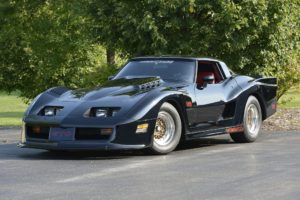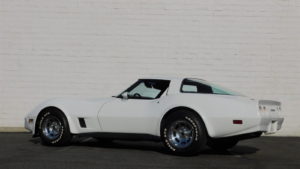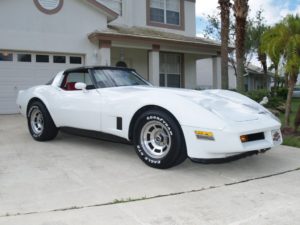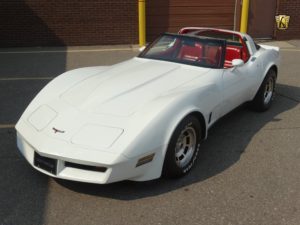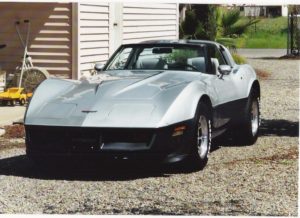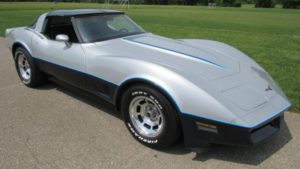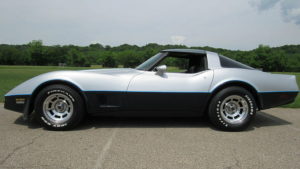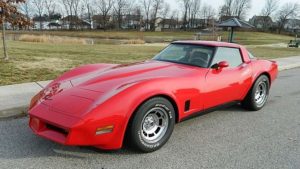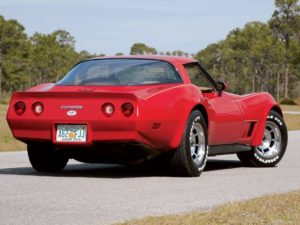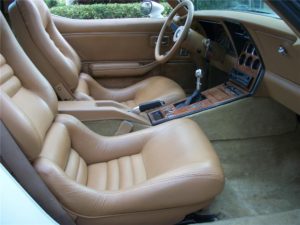Pricing: $16,258.52
Engine: 350ci, 190HP Engine (standard)
Transmission: 4-speed manual transmission, 3-speed Turbo Hydra-Matic automatic transmission
Units Produced: 40,606
Available Colors: Mahogany Metallic, White, Silver Metallic, Black, Bright Blue Metallic, Dark Blue Metallic, Silver Metallic, Dark Blue Metallic*, Charcoal Metallic, Beige, Yellow, Beige*, Dark Bronze, Red, Maroon Metallic, Autumn Red, Charcoal Metallic*, Dark Claret Metallic, Silver/Dark Blue, Silver/Charcoal, Beige/Dark Bronze, Autumn Red/Dark Claret.
Highlights of the year:
The 1981 Corvette fell under the umbrella of the progressively rising CAFE (Corporate Average Fuel Economy) standards. Because of this, Corvette production was again evaluated, though in this instance it was to determine what steps could be taken to improve the Corvette’s fuel compliance rating as well as help to improve GM’s compliance as a whole.
It was on this basis that the previous L48 & L82 350 cubic inch engines (offered with the 1980 Corvette) were retired in favor of a single, reworked engine which carried the designation L81. The L81 featured magnesium rocker covers and a stainless steel exhaust manifold.
The new, 350 cubic inch V-8 engine was rated at 190 brake horsepower at 4,000rpm and 280 lbs/ft peak torque at just 1,600rpm. The engine featured an auxiliary electric cooling fan that worked in conjunction with a smaller, engine-driven cooling fan, which aided in the reduction of noise.
As a result, the 1981 model year was the first since Corvette’s earliest days to offer a single-engine option for all models – including Corvettes built for sale in California.
However, the most substantial improvement to the 1981 Corvette over earlier models was the introduction of Computer Command Control (CCC). Though not unique only to the 1981 Corvette, Computer Command Control used electronics to integrate the emissions and fuel systems in order to reduce smog and fuel consumption. Similarly, CCC was tied into the automatic transmission’s new lockup torque-converter clutch. This provided a direct mechanical linkage between the flywheel and the prop shaft in second and third gears at steady-state speed, thus eliminating gas-eating frictional losses through the converter.
Cosmetically, the most notable changes to the car’s physical appearance occurred to its interior. The dashboard in the 1981 Corvette received a more modern and user-friendly makeover, including the introduction of a standard quartz clock and electronic tuning for all factory radios. A new six-way power driver’s seat was also introduced (one which finally reclined (a notable shortcoming of the seats in earlier third-generation Corvettes).
Outwardly, the car remained virtually identical as it had in 1980, with the exception of a new paint option – RPO D84 – that was offered exclusively for the 1981 Corvette.
The price of the 1981 Corvette had again increased from the previous model year to a base price of $16,258.52. Despite a generally dismal sales year for the entire automotive industry, Corvette continued to do well with 40,606 units sold that year.
Photos of the 1984 Corvette:
Sources:
https://www.mecum.com/lots/LN1117-297350/1981-chevrolet-corvette-coupe/
https://www.corvsport.com/1981-c3-corvette/
https://www.corvsport.com/1981-c3-corvette-image-gallery/
